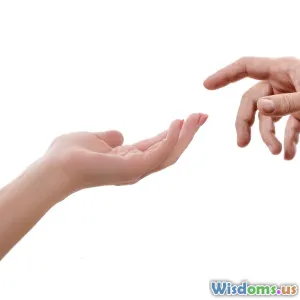
Living in Two Worlds Raising Children in Mixed Marriages
14 min read Discover the challenges and joys of raising children in mixed marriages, balancing two worlds and fostering cultural fluency and resilience. (0 Reviews)
Living in Two Worlds: Raising Children in Mixed Marriages
Introduction
What does it mean for a child to call two cultures home, to navigate conversations at the crossroads of race, tradition, and worldviews—sometimes even within a single dinner table discussion? The world is rapidly changing, and so too are family dynamics. Mixed marriages—whether crossing lines of ethnicity, nationality, race, or religion—are at their highest rates in recorded history.
According to the Pew Research Center, 17% of all marriages in the United States in 2015 were between spouses of different races or ethnicities, up from only 3% in 1967. But statistics are only part of the story. Behind each number is a unique narrative written daily—in kitchens simmering with foreign spices, in awkward family visits where etiquette is learned on the fly, and in children who answer "Where are you from?" with resilient, mosaic-like pride.
This article doesn’t just scratch the surface. Instead, it plunges into the real challenges, opportunities, and triumphs of raising children who belong to more than one world. We will reveal what parents and children actually encounter, tools that help children thrive, and why this journey, while demanding, offers some of the richest gifts of our evolving society.
The Modern Face of Mixed Marriages: A Growing Mosaic
The Numbers and Beyond
Today, families that span cultures and races are common in large urban centers and increasingly so in smaller towns and rural areas. In Canada, for example, mixed unions skyrocketed by 33% from 2001 to 2011. Globally, cities from London to Johannesburg are home to communities where second, third, and fourth-generation mixed-race children are crafting new, hybrid identities.
Mixed marriages today can encompass:
- Interracial unions (between different races or ethnicities)
- Binational marriages (between citizens of different countries)
- Interfaith relationships (across religious traditions)
- Cross-cultural partnerships (with differing values, traditions, and languages)
Each variation brings its own flavor and set of joys and challenges to the process of raising children.
Real-World Insights: The Diversity Within Diversity
Mixed families are not monolithic. For instance:
- Lila and Karl: Their daughter juggles German and Egyptian traditions, celebrating Oktoberfest one weekend and Eid the next.
- Maria and Jacob: Their children are raised with strong Catholic and Jewish traditions, experiencing dual holidays like Hanukkah and Christmas with both sets of grandparents.
No two families are the same, and neither are the worlds their children inhabit.
Balancing Dual Cultures: Double the Celebration or Double the Challenge?
Holidays, Rituals, and Language: Where it Gets Real
Children growing up in mixed marriages often enjoy “the best of both worlds.” They might decorate for Lunar New Year and Thanksgiving or learn lullabies in multiple languages.
But these layers of experience bring complexity. For instance, research published in Developmental Psychology suggests that bicultural children display greater flexibility and creativity but may also face identity confusion or pressure to “choose sides.”
Real Example: Maya’s Dilemma
Maya’s parents—one Filipino, one Norwegian—speak different languages at home. Maya’s exposure to both English and Tagalog helped her cognitive development; however, she sometimes felt “in between” and struggled when others insisted she identify with only one background at school functions.
Strategies That Work
- Consistent Rituals: Establishing clear traditions within the family (e.g., a weekly “culture night”) gives children grounding and pride.
- Open Communication: Parents who openly discuss what each tradition means foster understanding and curiosity in their children.
- Learning Together: Parents who show willingness to learn each other’s language or step out of their comfort zones set an example of respect and validation.
The Language Factor: More Than Words
A 2021 study by the European Commission found that multilingual children had higher literacy rates and adaptability in school. However, parents struggle with maintaining lesser-spoken heritage languages, sometimes feeling guilty if their children “lose” a language.
Parental tip: Celebrate every word your child knows without pressure. Encourage storytelling across languages—even if imperfect.
Navigating Differences: Parenting Styles, Discipline, and Family Expectations
Contrasting Upbringings Collide
Raising children together is challenging enough. When mixed marriages add clashing views on discipline, education, or even food, the pressure is palpable.
- Discipline: In some cultures, strictness is a sign of love; in others, it’s frowned upon. Children may get caught between conflicting approaches to rules and consequences.
- Education Goals: Parental aspirations often reflect their upbringing (e.g., careers in law vs. arts, or an emphasis on formal accolades over experiential learning). These can confuse or stress children.
- Diet: Food brings families together but can also divide. Imagine explaining why you can’t eat certain foods at a family gathering, or why one parent’s comfort meal seems alien to the other.
Real-World Example: Navigating Grandparent Roles
Sasha’s Russian grandparents expected daily visits and a tightly-knit extended family culture, whereas her Canadian grandparents championed independence. Sasha’s parents worked hard to explain the nuances to their daughter, helping her cherish both closeness and self-reliance.
Bridging Differences: Practical Steps
- Unified Front: Parents should agree privately on key decisions and present them as a team.
- Firm, Flexible Boundaries: Setting “non-negotiable” family rules while allowing room for adaptation reduces anxiety for both parent and child.
- Respectful External Communication: Parents can model how to respectfully disagree or explain their choices to relatives, teaching children assertiveness and diplomacy.
Identity Challenges: Claiming, Defending, and Celebrating “Both Worlds”
The Question: “What Are You?”
It’s one of the most jarring inquiries for children of mixed marriages. Actor Keegan-Michael Key recalls feeling out of place, neither “black enough” nor “white enough.” This “in-between” space can spark anxiety, but it can also forge resilience.
Fighting Stereotypes and Bias
Children may encounter discrimination or stereotypes from both within and outside their family circles. According to a 2020 study from the UK’s Office for National Statistics, 11% of mixed-race children reported bullying linked to their background.
Positive Approach: Empathetic Help
- Open Dialogues: Encourage children to express their feelings about experiences at school or in public.
- Real-Life Role Models: Expose children to successful figures from similar backgrounds—musician Norah Jones, athlete Naomi Osaka, or public figure Barack Obama—who openly discuss their multicultural heritage.
- Workshops and Books: Children’s books like The Name Jar or All Are Welcome foster discussion and pride.
Supporting Self-Definition
Instead of confining children to one “box,” ask how they see themselves. Some may embrace hyphenated identities (Korean-Canadian); others may prefer no labels, identifying simply as “me.”
Quote: “My identity isn’t a preset menu; I can mix, choose, and invent new flavors,” says Charisse, a college junior of Nigerian-Filipino-German ancestry.
Keys to Identity Resilience
- Affirmation from Family: Praise the unique qualities inherited from all cultures.
- Cultural Immersion: Travel, language, dance, or food—authentic exposure deepens bonds.
- Safe Spaces: Find communities (even online) where shared experiences are validated.
Creating a Home of Shared Values
Beyond Diversity: Building a Unified Family Culture
While honoring heritage is vital, so is creating “third space”—a blend where unique family traditions emerge. Philosopher Stuart Hall’s theory of cultural hybridity posits that identities aren’t fixed but constantly negotiated, especially in mixed families.
Example: Tiana’s family celebrates “Pizza Sabbaths”—combining Friday night Jewish Sabbath rituals with her Italian father’s pizza-making. Over time, their home became the favorite hangout for kids eager to swap stories and slices.
Core Values Unite
Ethics like kindness, honesty, and responsibility transcend all backgrounds. By focusing on core values, parents provide consistency amid all the flux. Family discussions about fairness, inclusion, and perseverance set a moral GPS, no matter the cultural terrain.
Practical Parenting Strategies for Mixed Marriages
1. Make Storytelling Central
Regularly share family stories, struggles, and triumphs from both backgrounds. Researchers note that children with a strong “family narrative” show improved self-esteem and emotional wellbeing.
2. Encourage Curiosity and Language Learning
Normalize switching between languages, tasting new cuisines, and questioning everything. Don’t fear mistakes; they’re part of adaptation.
3. Plan Rituals and Traditions Intentionally
Choose special holidays or moments from each heritage. Even small gestures—like Sunday pancakes or Diwali candles—build a sense of “this is ours.”
4. Address Identity Challenges Early
Don’t wait for incidents of confusion or bullying. Have ongoing conversations about cultural differences, stereotypes, and the beauty of belonging to more than one group.
5. Build a Support System
Seek out diverse schools, friend circles, or online forums specializing in bicultural or mixed-race family experiences. Community normalizes uniqueness.
The Unique Gifts: What Children Gain from Living in Two Worlds
Resilience and Resourcefulness
Children in mixed marriages learn, from a young age, to negotiate differences, decode unfamiliar situations, and advocate for themselves. These are skills that employers, universities, and social movements value deeply.
Creativity and Flexibility
Studies find that bicultural or multicultural individuals demonstrate above-average creativity (Thomas & Inkson, 2020) and heightened empathy and perspective-taking.
Broadened World Scope
Children raised in mixed marriages often become natural bridge-builders—comfortable in diversity, unafraid of difference, and open-minded global citizens.
“We get to choose what carries forward. We’re not just products of the past—our family makes new stories,” explains Kavita, now a mother to half-Indonesian, half-Irish twins.
Conclusion: Bridging Worlds, Building Futures
Raising children in mixed marriages isn’t just about managing holidays or learning extra recipes. It’s about integrating, navigating, sometimes struggling, but always expanding. Every family, whether mom is Christian and dad is Muslim, or one parent is Irish and the other is Liberian, walks a unique path—a path rich with possibility.
When parents lead with openness, communication, and pride, children thrive—not in spite of their hybrid worlds, but because of them. These children, standing on the thresholds of cultures, languages, and expectations, remind us that belonging is not about walls or borders—but about bridges and the stories we create together.
Let your family story be one of joy and discovery. Celebrate what’s different, nurture what’s shared, and watch as your children turn two worlds into their own remarkable home.
Rate the Post
User Reviews
Other posts in Cultural Differences in Marriage
Popular Posts
















